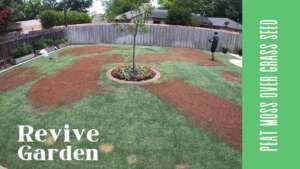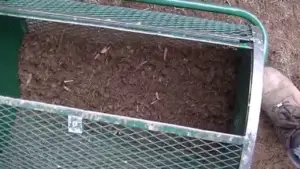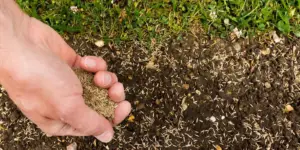Table of Contents
 Who wants to haul around a heavy bag of grass seed and work day in and day out trying to get rid of those pesky weeds? Not me! Peat moss over grass seed has been an easy, cheap, and effective method for many years. If you have never tried peat moss over grass seed, read on so you can try it yourself.
Who wants to haul around a heavy bag of grass seed and work day in and day out trying to get rid of those pesky weeds? Not me! Peat moss over grass seed has been an easy, cheap, and effective method for many years. If you have never tried peat moss over grass seed, read on so you can try it yourself.
In this article, we’ll explore the usage of peat moss over grass seed, what it is used for, and the difference between fertilizer and peat moss, including their disagreements. Before ending this article, we will be able to understand which would be the best in your situation. We’ll also cover a few pros and cons to help your lawn look amazing as it’s the first impression on your guests visiting your home.
Explore more about natural grass control methods by exploring how cayenne pepper can kill grass in our comprehensive guide.
Peat Moss Over Grass Seed – Which is better
It has been used for thousands of years as a soil amendment in gardening and landscaping because it improves drainage and moisture retention in sandy soils.
Peat moss is a type of moss that grows in wetlands. It is often used as a ground cover or mulch in gardens. Peat moss has high water content and can hold large amounts of water, making it ideal for drought-prone areas. Peat moss is also known for improving soil drainage and aeration.
It is a popular growing medium for lawns but can also be used as an alternative to peat. It is made from decomposed organic matter and is often used as a fertilizer for garden plants. Peat is a good choice for beginner gardeners because it’s easy to find and inexpensive. It has been used for thousands of years as a soil conditioner, but many people don’t realize you can also use moss in your garden plants’ soil.
How Much Peat Moss To Use?
The amount of peat moss depends on the lawn’s size and purpose. For overseeding, apply 1/8 to 1/4 inch thickness. For new lawns, use 1/4 to 1/2 inch. Avoid excessive thickness, as it can hinder growth. Calculate the needed peat moss based on square footage and desired depth. Remember, proper watering and care are crucial for success.
How To Use Peat Moss?
To prepare a peat moss recipe over grass seed, you will need:
1 pound of turf builder or garden lime (or 1/2 cup of hydrated lime).
1 pound of lawn fertilizer (5-10-5 or 10-10-10).
1 bag of peat moss.
How to Apply On Lawn?
If you want to use peat moss as a seed starter medium,
prepare your planting area by clearing weeds and removing rocks or other debris from the soil surface.
Till the soil, if it is compacted or hard to work with, then rake it smooth and level with the surrounding area so that your seeds are evenly spaced when they germinate.
Spread 1 inch of peat moss on the soil surface and then water thoroughly until the soil beneath it has absorbed all of the peat.
This will help settle any air pockets in your planting bed so that when you sow your grass seed, they don’t float on top of the soil surface instead of sinking into it where they need to be to grow properly once this step has been completed, spread out your grass seeds evenly over top of the soil.
Curious about the growth cycle of grass? Learn more about when the grass stops growing in our comprehensive guide
Benefits of Peat Moss

Peat moss has many benefits for gardens and lawns, including the following:
- Peat moss helps improve soil drainage and aeration.
- Peat moss increases water retention in sandy soils.
- Peat moss helps to lower the pH of acidic soils.
- Peat moss can help reduce compaction in heavy clay soils.
Nutrients Of Peat Moss
Peat moss provides essential nutrients for plants, including nitrogen, phosphorus, and potassium. Peat moss also contains beneficial microorganisms that help improve soil health.
| Nutrient | Content in Peat Moss |
| Nitrogen (N) | Low to Negligible |
| Phosphorus (P) | Low to Negligible |
| Potassium (K) | Low to Negligible |
| Calcium (Ca) | Low |
| Magnesium (Mg) | Low |
| Sulfur (S) | Low |
| Iron (Fe) | Low |
| Manganese (Mn) | Low |
| Zinc (Zn) | Low |
| Copper (Cu) | Low |
| Boron (B) | Low |
| Molybdenum (Mo) | Low |
Results Of Overdose Peat Moss On Lawn
As the amount of peat moss required for a lawn is not based solely on lawn size, and the overdose consequences are primarily related to the thickness of the application rather than a specific dose, it is challenging to provide an exact chart. However, I can create a simplified chart that outlines the recommended application depth for peat moss based on the lawn’s status (overseeding or new lawn) and the potential overdose consequences:
| Lawn Status | Recommended Peat Moss Depth | Overdose Consequences |
| Overseeding | 1/8 to 1/4 inch (0.3 to 0.6 cm) | Nutrient imbalance reduced oxygen availability |
| New Lawn | 1/4 to 1/2 inch (0.6 to 1.3 cm) | Nutrient imbalance, reduced oxygen availability, altered soil pH, moisture retention issues |
Pros and Cons of Using Peat Moss
| Pros of Using Peat Moss | Cons of Using Peat Moss |
Cons of Using Peat Moss:
|
Unsustainable Resource:
|
Excellent Water Retention:
|
Low in Nutrients:
|
Promotes Seed Germination:
|
Acidity Concerns:
|
Organic Matter:
|
|
Lightweight and Easy to Handle:
|
|
| pH Buffering:
Acts as a buffer, stabilizing soil pH |

Cost Of Peat Moss
The cost of peat moss can vary depending on several factors, including the brand, quality, quantity, and location. Prices may differ based on purchasing peat moss from a local garden center, nursery, or online retailer.
Generally, peat moss is available in various packaging sizes, such as small bags (e.g., 1 cubic foot) or larger bales (e.g., 2.2 cubic feet or more). The cost per bag or bale can range from a few dollars to around $30 or more, depending on the size and brand.
To get the most accurate and up-to-date pricing information, it is recommended to check with local gardening supply stores, home improvement centers, or online retailers offering sale peat moss. Prices may have changed since my last update, so it’s essential to research the current market prices in your specific area.
if you’re curious about the differences between Tall Fescue and Kentucky Bluegrass. Learn more in our comprehensive comparison guide.
How is Peat Moss the Best Choice?
Due to its unique properties and benefits, peat moss is the best choice for gardening and horticultural applications. Here are some reasons why peat moss is often regarded as an excellent option:
- Soil Amendment: Peat moss improves soil structure by enhancing aeration and drainage. It helps loosen compacted soils, making it easier for plant roots to grow and access nutrients and water.
- Water Retention: Peat moss has exceptional water-holding capacity, which helps maintain consistent soil moisture. This property is especially beneficial for seed germination and establishing young plants.
- Nutrient Retention: Peat moss can retain and slowly release essential nutrients, making them available to plants over time. This nutrient-holding ability reduces the risk of nutrient leaching and ensures a steady supply for healthy plant growth.
- pH Buffering: Peat moss acts as a pH buffer, stabilizing soil pH levels. It can counteract acidity or alkalinity, creating a more suitable growing environment for many plants.
- Organic Matter Addition: Adding peat moss to the soil enriches it with organic matter, which supports beneficial microorganisms and improves overall soil health.
- Seed Germination: The consistent moisture and aeration provided by peat moss make it an ideal medium for successful seed germination.
- Lightweight and Easy to Handle: Peat moss is lightweight and easy to transport and spread, making it convenient for various gardening and landscaping projects.
- Disease Resistance: Peat moss is naturally resistant to many common plant diseases, reducing the risk of soil-borne infections in the garden.
- Sustainable Sourcing: While it is true that peat moss is not a renewable resource, some brands are now focusing on sustainable peat harvesting practices, minimizing environmental impact.
While peat moss offers many benefits, it is not the best choice for all situations. Some environmental concerns arise due to the non-renewable nature of peat bogs, which serve as critical ecosystems. Sustainable alternatives like compost, coir, or various types of organic matter can also be considered for soil improvement and water retention.
Learn about the benefits of using hay on grass seed in our comprehensive guide, and discover how this natural method can enhance your lawn’s growth.
Conclusion
Peat moss has many benefits over grass seed, especially regarding nutrient retention. It can hold onto nutrients that would otherwise be lost, making it more efficient to fertilize your lawn. This article provides information about resistance to compaction, which belongs to Peat moss over grass seed. If you would like to add any relevant information, leave it in the comment box so we may also benefit.
